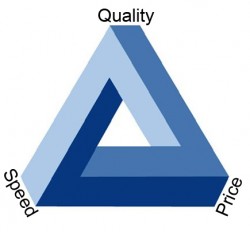
Comparison – you’re doing it wrong.
There have been lots and lots of posts about how newly introduced Apple iPad compares to other similar devices that are either currently on the market or very close to be there. Somehow almost everyone fails to understand while comparing all these devices – and what they will inevitably realize while actually using them – is that size does matter. Size of the screen that is. There is a certain threshold in a screen size. Go below – you’ve got a pocket computer, hopefully with a working phone. Go above that and you’ve got a laptop in its raw form – something that fits on your lap. Either would serve different purposes, either may – or may not – serve as a partial replacement for another.
This threshold is somewhere around 7″ to 8″ screen. Most of the stuff below that would fit into pocket almost anything above that would not. Maybe the only orphan here would be Sony Vaio P-series with it’s ultra-useless-wide 8″ screen. It is as elegant as it is useless.
Comparing Nokia’s smartphone to Archos’ media player to Apple’s iPad computer is wrong. You are comparing apples to oranges to kiwis. While they all fruit you can’t really say which one is better. All depends on purpose and the purpose is different all across the board. Nokia N900 is a good smart phone. Archos 7 is an excellent multimedia device. Sony Vaio P series is a perfect thing to keep your pocket fully stuffed. iPad is none of those – it’s not a phone, it doesn’t fit into one’s pocket and it so much more than a multimedia player that Apple even pushed iWork demo for it – just to prove their point. I don’t think anyone would prefer using iPad for office tasks over regular PC or laptop, but the idea that iPad is more than sophisticated movie player/e-book reader should have been pushed through nonetheless.
So what should we compare iPad to? Unfortunately for consumers there are not that many devices you may compare this to. There are a few laptops with touch screens by Toshiba and Lenovo, there’s Asus Eee PC T91 with touch screen. They all way heavier than iPad. They all are pretty poor on batter life. Although we haven’t seen iPad yet, but something tells me Apple will get past 7-hour mark (another threshold!). They all have resistive technology screens whereas iPad sports capacitive, which is more convenient for general everyday use. iPad has got a slower CPU, but it’s irrelevant given the tasks you would be doing on such device. Remember how you chatted or browsed the internet or used Facebook just the same three years ago? Lack of Flash would actually protect the end-user from negative performance hits, everything else would feel just the same.
Two or three months is not a significant time frame for any competition to emerge with anything close to iPad. Yes, Microsoft and HP had partnered to introduce their tablet PC two weeks earlier, but what is that device, really? There are no specs, no real pictures (except those from CES), no dates. Sorry, folks, but if you want a tablet – you stuck with iPad. For now.
 The trade-offs that small businesses are making are wrong. Well, most of them are. Look at the picture on the left and it will get obvious that you can’t just tweak one of the parameters without compromising other two.
The trade-offs that small businesses are making are wrong. Well, most of them are. Look at the picture on the left and it will get obvious that you can’t just tweak one of the parameters without compromising other two.